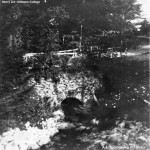Succession                            By: Claudia Corona                             12/07/09
Where Ford Glen brook had been covered in green luscious vegetation months ago, everything was now covered in white. It was as if my site had turned into a completely different environment overnight. Before I dug a hole, I looked around at my site. Most of the trees that had been stripped of leaves last week were now covered in white clumps of snow, the Ford Glen trail was completely unrecognizable in the snow, and even the still present ferns could no longer boast their color, having been covered with a blanket of white snow . It was a bit windy, but very bright at 10:30 in the morning, which made the scene even more breathtaking, especially when the wind would sway the tree branches and white powdery snow would sprinkle down from the high trees.
I went further into the woods, and chose to dig a 24 in. by 12 in. by 6 in. deep rectangular hole. I chose a spot where there were no trees for a couple of meters on either side and I dug. I kept digging until I hit these big red cylindrical branch-like things inside the whole. At first, I thought they were crab legs because they had a red color and a white hue to them, but then I broke one and saw that it was moist and looked like the inside of a tree, there were lots of them in my way and I couldnât dig them out, which lead me to believe that they were the roots of a tree so I left them there and observed the soil layers in my site.
I didnât see any clear definable soil layers in the hole. I couldnât discern the organic layer from the A layer of minerals. After the leaf litter and the dirt and decomposed matter, all I really saw was a mixed up layer of dark brown soil filled with small twigs, little rocks, and shiny, wet, soft soil, probably the mineral layer that meshed with the B layer.
Since the native americans that inhabited this area werenât excessive tree choppers like the first colonials, this forest must have at one point been filled with old hemlocks and undisturbed, rich soils.
Looking at the types of tree species that my site has; striped maple, black/yellow birch, sugar maples, beech, and some hemlock, this used to be a wood lot, maybe less than a hundred years ago, by the looks of the medium-sized tree trunk girth of the majority of the trees. The wood lot was abandoned and pioneer species came to repopulate the land, the first being striped maple and black/yellow birch, followed by the rest of the trees previously said.
According to Clementâs theory of succession, my site has gone through several phases of succession. The first phase occurred when the old-growth forest became disturbed and succession began with the development of the new site, known as nudation. After the forestâs natural processes had been disrupted and then abandoned, migration occurred, the second phase, which is when the striped maple and black/yellow birch came in. Ecesis, the third phase, occurred soon after, which established the initial growth of the vegetation. As the vegetation became well established, grew, and spread, species began to compete for space, light and nutrients, called competition, phase number 4.
After several years of the striped maple and the birch becoming well established, other plant communities came in, called the reaction phase, where there is a replacement of one plant community by another, known as phase 5. Phase 6 is the stabilization phase, which leads to the development of a climax community, where everything is in equilibrium.
I believe Ford Glen brook is in phase 5. The forest has been left to thrive on its own for a couple of decades now, pioneer species have dwindled in numbers and other species, such as sugar maple and beech, another wave of tree species, has come in and begun to dominate the area. Decades from now, and if there are no major disturbances, such as clear-cutting, then the sugar maple and beech will start to decrease in number as hemlocks will start to come in, which are the next wave of oldest growing trees. If Ford Glen is left alone, with time it can naturally change to become as rich in soil and minerals as it was before colonialism, all we have to do is let nature take its course.
Source: http://www.answers.com/topic/ecological-succession-1


 The Path Less Traveled By –Claudia Corona
The Path Less Traveled By –Claudia Corona